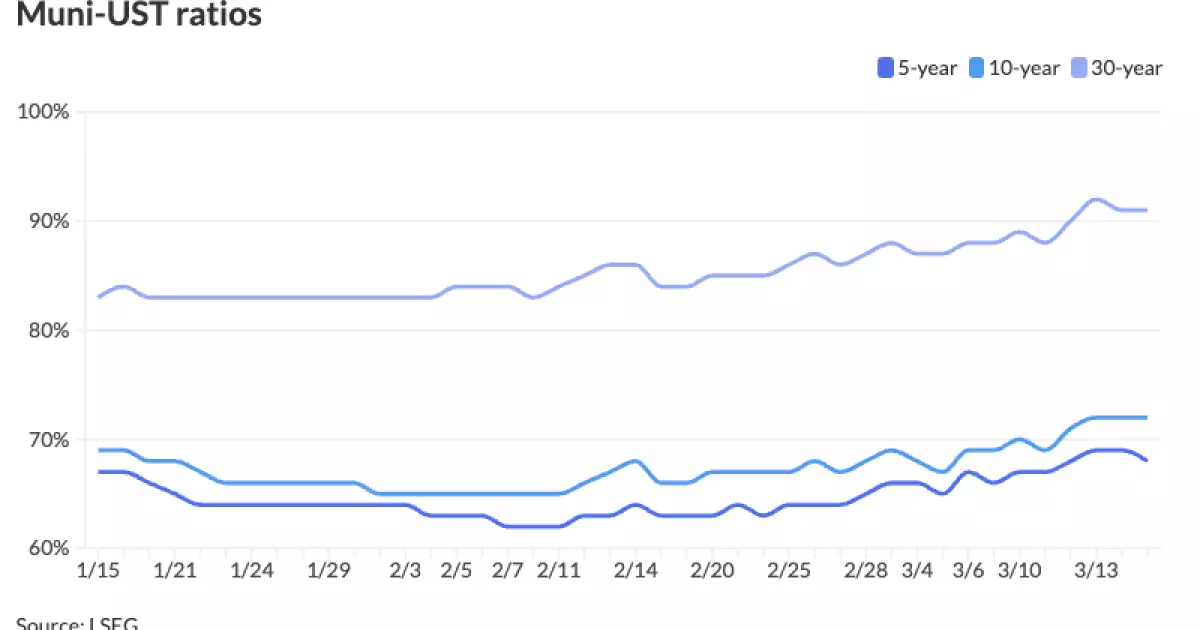As we navigate through the complexities of the current financial landscape, municipal bonds find themselves in a precarious position. Recent developments have highlighted an unsettling trend: supply is outpacing demand, causing severe strain on prices and yields. Investors are understandably unnerved, with recent municipal bond losses reported at 1.41% for the month, effectively wiping out earlier gains for the year. This is particularly concerning for a sector that traditionally serves as a safe haven amidst volatility in the broader market. The challenges don’t just end there; a looming threat of tariff wars and anticipated layoffs intensify the strain, making any hint of recovery seem increasingly distant.
The Yield Conundrum
Jason Wong from AmeriVet Securities aptly remarked on the shocking increase in municipal yields, which surged by an average of 15.1 basis points last week alone. Long-term investors should be particularly alarmed, as the long-end of the curve experienced cuts of about 20 basis points. The metrics indicate that munis are now at their most affordable relative to U.S. Treasuries in over a year, with long-dated munis hovering around 90%. It’s worth contemplating whether this situation is a unique opportunity for investors or merely a terrifying indicator of deeper systemic issues. While some may argue that lower prices entice buyers back into the market, one must consider the unhealthy tech environment that could strangle any potential recovery.
The Dismal Outflows and their Implications
Recent data from LSEG Lipper strikingly reveals that municipal mutual funds suffered an outflow of $373 million. What is alarming, however, is that this enormous retraction was concentrated entirely in investment-grade funds. Such outflows can create a vicious cycle; as liquidity dries up, the ensuing bidding wars force prices even lower, squeezing institutional investors and squeezing retail ones out of the market entirely. The stark increase in bid-wanteds—31% over the past week—further underscores an urgent need for caution among retail investors and suggests that many players may be fleeing from perceived instability.
Current Issuance: A Double-Edged Sword
Despite the grim circumstances, issuance in the municipal bond market is reportedly up 16.7% year-over-year, inching closer to the $100 billion mark. However, this statistic can mask the significant challenges that lie ahead. Increased issuance might initially appear to be a favorable sign, yet it poses grave risks if the flow of funds weakens. Should investment-grade funds stall or continue to bleed, the resulting oversupply could serve as an anchor on prices, making recovery even less attainable. Hence, while issuance may hint at optimism, it is crucial for investors to remain skeptical and question the sustainability of such growth amidst turmoil.
The Long-Term Outlook: A Glimpse of Hope or a Dismal Future?
Amid this backdrop of chaos, some experts are asserting that investors willing to scoop up municipal bonds at deflated prices may be positions for future gains. This “buying the dip” mentality, however, is fraught with risk. While many may see merit in investing at these low points, anyone involved in municipal bonds should practice a high degree of caution and preparedness for unexpected shocks like unanticipated economic events or regulatory changes that could derail the market further. In a world where prevailing political narratives shift quickly and the economic forecast appears bleak, the notion of “cheap paper” may induce more dread than anticipation.
Primary Market Activity: More of the Same?
Looking toward upcoming issuances, entities such as the Alabama Federal Aid Highway Finance Authority and the San Diego Unified School District are preparing their own bond offerings. Yet the meager confidence existing in the market begs the question: who will step up to buy these bonds amidst the prevailing climate? If historical data serves as any indication, any new emissions will likely have to come at extremely low prices to attract necessary investments. The clear risk here is a potential standoff between issuers and unwilling buyers, which could further exacerbate the market’s current tumultuous state.
The drop in municipal bond confidence signals wider economic issues at play, challenging credible investment strategies while painting a disheartening view on financial stability. As municipal bonds grapple with adverse conditions, the call for vigilance, adaptive investment strategies, and a realist perspective has never been more urgent.

